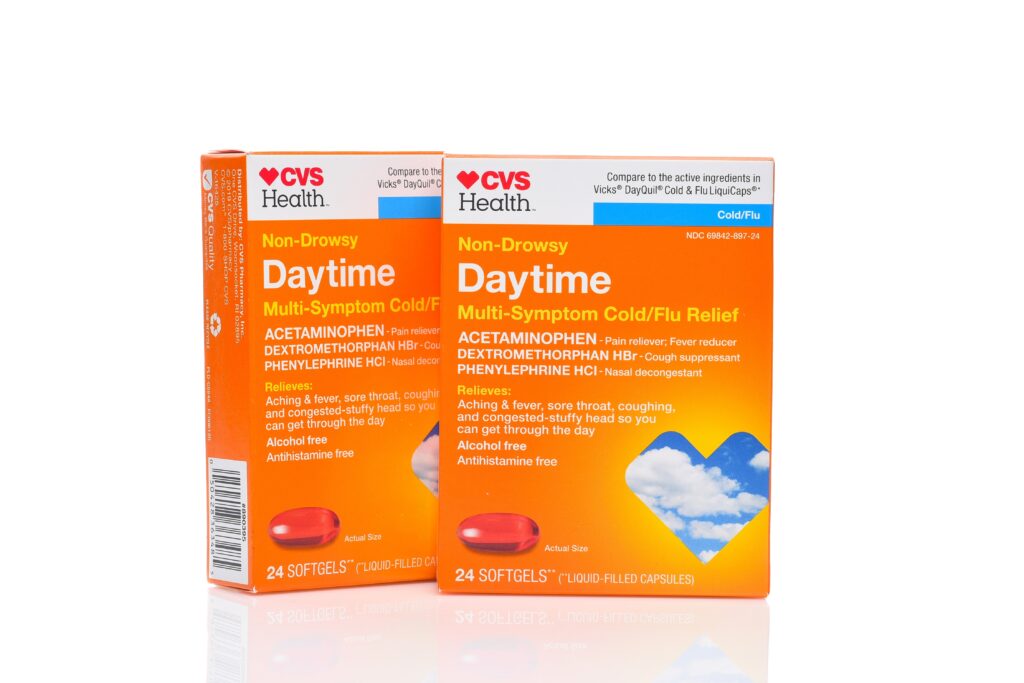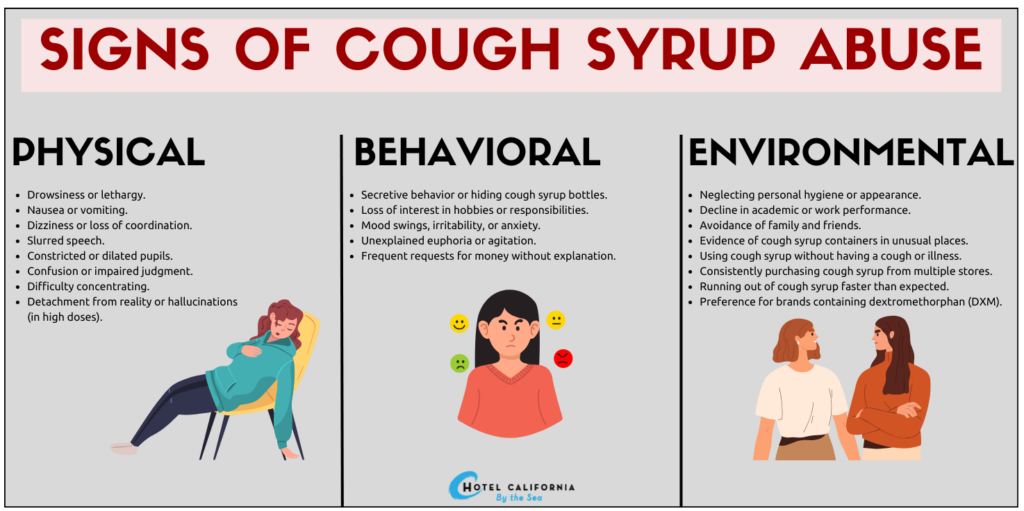What is Robotripping?
Robotripping is a form of substance abuse that is characterized by ingesting products like Robitussin, cough syrup or other over-the-counter medications that contain dextromethorphan (DXM), in high doses, in an attempt to get high. At high enough doses, users can experience psychological and physical effects such as euphoria, and auditory and visual hallucinations. Despite being the main active ingredient in many household medicines, when abused, DXM can result in dangerous side effects. Cough syrups are most often not on parent’s radar. This is because it is so common in homes. However, robotripping and abuse of DXM are most commonly found among teens and young adults.

For some teens, getting high can be as simple as going through their medicine cabinet and taking over-the-counter cough medications in high doses. Most cough medications contain DXM. There are around 125 over-the-counter medicines sold that contain the ingredient and are easily accessible and available for purchase without a prescription. Robotripping is not a new trend. It has existed among teens, adolescents and young adults in the US for quite a while. A survey about the substance trend showed that robotripping peaked around 2006 and has slowly been on the decline since 2011.
Through misinformation and social media, robotripping is often portrayed as a safer way to get high. This could not be far from the truth. At high enough doses, DXM contains hallucinogenic properties that can lead to life-threatening adverse effects and the development of a substance addiction.
What is DXM?
Dextromethorphan is an opioid substance found in many different over-the-counter medications for cough and cold. These medications are available in liquid form, lozenges, and in extended-release tablets. Common medication brands that contain DXM that are often used for robotripping include NyQuil LiquiCaps, Vicks DayQuil, Coricindin HBP Cough and Cold, and Triamine Thin Strips. There are many non-brand generic medications that also contain DXM alongside other active ingredients such as acetaminophen and pseudoephedrine. The combination of these substances in high doses can also pose a dangerous threat.
Robotripping and the abuse of DXM-focused medications have become such a problem that many states have put restrictions on the sale and purchasing of these products. In the US, 15 states banned sales of DXM products to minors. However, this has not stopped teens from gaining access to the drug.
Signs of DXM Abuse and DXM-related substance use disorder
- Cravings for DXM that are intense enough, can affect your ability to think about other things
- Developing a tolerance and the need to use more DXM in order to experience the same effects
- Feeling unease and discomfort when you don’t have access to DXM
- Difficulties with work, school or personal responsibilities
- Friendship and relationship difficulties
- Spending less time on activities you once enjoyed
- Experiencing withdrawal symptoms when DXM use has slowed down or stopped

What is Robotripping?
Robotripping, dexing, Triple C, Poor Mans PCP or Skittling are popular names that refer to the abuse of DXM to experience euphoric and hallucinogenic effects. A simple online search for the term robotripping can result in tons of information about what products to use and how to use them.
So what is the appeal to use DXM or engage in robotripping? Some of the main reasons why teens engage in this type of substance abuse are to experiment out of curiosity and peer pressure or to self-medicate and ease mental health conditions. Teens also believe it is a safer alternative to getting high because they are not using what is considered “hard drugs” like heroin or cocaine. The ease of use and availability are also important factors in why teens abuse DXM. It’s cheap, it’s easy to find, and you can achieve a similar effect or high to that of other hallucinogenic drugs.
So how are teens abusing these everyday, over-the-counter, drug store medications?
- Drinking multiple bottles of cough syrup
- Swallowing large doses of cold relieving gel capsules or pills
- Mixing powdered DXM with food or drinks
- Crushing cold and cough tablets containing DXM and snorting the powder
- Mixing in cough syrup medication with soda or other liquids to produce a drink also referred to as lean
The effects of a DXM high can take into effect around 30-60 minutes after the first dose. According to a 2014 study published in the Journal of Anesthesiology and Pain Medicine, the effects of robotripping usually last between 2-6 hours. However, if the DXM product is used in conjunction with other drugs, the effects can linger for longer. How long the effects last will depend on factors such as the other ingredients, individual BMI and metabolism rate, and the presence of other health conditions.
Side Effects of Robotripping
- Increased body temperature, hot flashes and sweating
- Nausea and dizziness
- Slurred speech
- Lethargy
- Hyperactivity
- High blood pressure and irregular heartbeat
- Slowed breathing
- Involuntary eye movements
- Unconsciousness
- Seizures
- Increased anxiety and nervousness
- Hallucinations and dissociative episodes
- Cognitive impairments – impaired judgment and poor decision-making
- Increased risk of violence and out-of-character behavior
- Dependency and addiction
What happens during a Robotrip session?
- 100-200 milligrams – During this first phase, the user can experience mild effects such as an uplifted mood, more energy and similar effects to that of taking ecstasy.
- 200-400 milligrams – During this second phase with increased amounts of DXM, the effects are compared to that of alcohol intoxication with a more noticeable decline in cognitive functions and motor skills. Users will feel a sense of euphoria along with visual and auditory hallucinations.
- 400-600 milligrams – During this third plateau, users will experience sensations and effects similar to that of a ketamine high. This includes dissociation, loss of motor coordination and intense hallucinations.
- 500 milligrams or more – During this fourth plateau, the user has taken an extremely high dose and can experience effects similar to PCP. This includes hallucinations, delirium, a trance and out-of-body experience which can linger on for up to two weeks even after drug use has stopped.
Check Your Insurance Coverage for FREE
Find out if your insurance covers addiction treatment in minutes. We accept most insurance!
The Risks and Dangers of Robotripping
- Heatstroke – DXM can interfere with the body’s ability to regulate and maintain temperature and cause temperature spikes.
- Toxicity and overdose – Some people are able to effectively metabolize DXM and can cause the body to go into overdose resulting in blurred vision, rapid heartbeat, slowed or shallow breathing, nausea and vomiting as well as seizure and coma.
- Respiratory Depression – DXM can depress the central nervous system and stop the lungs from receiving the necessary oxygen resulting in slowed breathing and death.
- Liver damage – Many over-the-counter cold and cough medications not only contain DXM, but also contain acetaminophen. This ingredient is processed in the liver and when the body is flooded with high doses, can cause toxicity and damage to this organ.
- Violent or dangerous behavior – With high doses of DXM, users can develop strange behaviors stemming from hallucinations, psychosis and agitation. This often causes the user to lose touch with reality, engage in erratic behavior and make them do things they would not normally do.
- Nausea and intense vomiting
- Seizures and brain damage
- High blood pressure – DXM abuse causes rapid heartbeat and increased blood pressure
- Paranoia and psychosis
- Serotonin syndrome – A condition in which the body is consumed with too much serotonin leading to life-threatening conditions.
- Addiction and overdose
What to look out for if you suspect your teen or someone you know is Robotripping
- Loss of motor control and slurred speech
- Experiencing hallucinations
- A decline in school work as well as relationships with friends and family
- Loss of interest in activities once loved
- Intense mood swings and erratic behavior
- Use of slang words such as Triple C
- Finding excess cough medications in bottles and packets
- Running out of cough medication faster than usual
Reach out to Hotel California by the Sea
We specialize in treating addiction and other co-occurring disorders, such as PTSD. Our Admissions specialists are available to walk you through the best options for treating your addiction.
Treatment for Substance Use Disorder
Robotripping and the abuse of DXM can lead to serious consequences of long-term effects such as learning problems and memory impairment in teens. In a 2006 survey funded by the National Institute of Drug Abuse, studies found that abuse of DXM occurred mostly in teens ages 12-17. The popularity of robotripping is fueled by misinformation on its dangers, the accessibility of the drug as well as ease of use. Long-term misuse of DXM also increases the risk of developing a substance use disorder. Behavioral health treatment programs such as Hotel California by the Sea provide effective treatment for clients abusing drugs such as DXM.
We offer treatment at all levels of care including detox, residential, PHP and IOP. We utilize evidence-based treatment programs such as CBT, DBT, EMDR therapy and family therapy. Hotel California by the Sea is dedicated to helping our clients achieve their goals of sobriety and overcoming their addiction.
References:
https://www.healthline.com/health/robotripping
https://zinniahealth.com/substance-use/dextromethorphan/robotripping
https://www.drugrehab.com/addiction/drugs/dextromethorphan/robotripping
https://www.embarkbh.com/blog/substance-use/robotripping-a-guide-for-parents-of-teens/
https://clearbehavioralhealth.com/robotripping/
